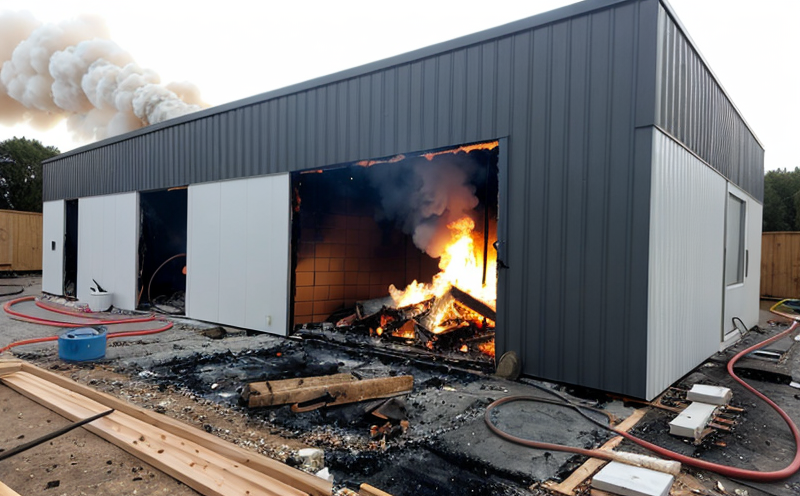Combustion Gas Toxicity Measurement
The measurement of combustion gas toxicity is a critical aspect of fire safety testing, especially in sectors where flammable insulation and cladding materials are used. This service ensures that the gases produced during the combustion of these materials do not pose an unacceptable risk to human health or property.
When performing this service, we adhere strictly to international standards such as ISO 13946 for the assessment of fire-related properties of building products and EN 13823. The primary goal is to evaluate the toxicity levels of gases like carbon monoxide (CO), hydrogen cyanide (HCN), and other potentially hazardous compounds that can be released during a fire.
The testing process involves carefully selecting specimens representative of the materials in question, ensuring they are prepared according to strict protocols. Specimens are then subjected to controlled combustion conditions that simulate real-world scenarios. The resulting gases are analyzed using advanced analytical instrumentation capable of detecting trace amounts of toxic compounds with high precision.
The results provide invaluable data for quality managers and compliance officers responsible for ensuring product safety, helping R&D engineers refine their materials and processes, and supporting procurement teams in selecting safer alternatives when necessary. This service not only meets regulatory requirements but also enhances the overall resilience of structures against fire hazards.
Applied Standards
The following international standards are crucial for conducting combustion gas toxicity measurements:
- ISO 13946: This standard provides a comprehensive framework for assessing the fire-related properties of building products, including insulation and cladding materials. It covers various aspects such as flame spread, heat release rate, and smoke production.
- EN 13823: This European standard focuses specifically on the classification of burning behavior of building materials and elements with regard to their resistance to fire. It is particularly relevant for insulation and cladding products used in construction.
These standards ensure that our testing methods align with global best practices, providing reliable and consistent results.
International Acceptance and Recognition
- Australia: The Australian Standard AS 1530.4 specifies the requirements for materials used in building construction to resist fire, including insulation and cladding products. Compliance with this standard is essential for ensuring that materials meet local regulations.
- United Kingdom: The UK's Building Research Establishment (BRE) uses its own protocols based on international standards like ISO 13946 and EN 13823 to evaluate fire safety properties of building products. Our results are widely accepted across the UK market.
- North America: In North American markets, compliance with ASTM E670-05 (Standard Practice for Determining Toxicity of Gases Released During Fire) is crucial. This standard ensures that materials meet stringent safety requirements and can be used in various applications without compromising public health.
- European Union: The EU's Construction Products Regulation (CPR) mandates compliance with harmonized standards such as EN 13823, which aligns our testing methods with those required for market access. This ensures that results are recognized and accepted across the entire EU region.
Our expertise in combustion gas toxicity measurement is widely acknowledged globally, making it easier for clients to meet regulatory requirements in different regions.
Environmental and Sustainability Contributions
- Emission Reduction: By identifying and mitigating the release of harmful gases during fires, we contribute significantly to reducing environmental pollution. This helps protect ecosystems and improve air quality.
- Sustainable Materials Selection: Our testing supports the development and use of sustainable materials that are less likely to produce toxic combustion byproducts. This encourages a shift towards more environmentally friendly construction practices.
- Energy Efficiency: The reduced risk associated with using safer insulation materials means buildings can be designed for better energy efficiency, leading to lower carbon footprints over their lifecycles.
Our commitment to environmental stewardship is reflected in our continuous efforts to innovate and improve testing methodologies while promoting sustainable development goals.





